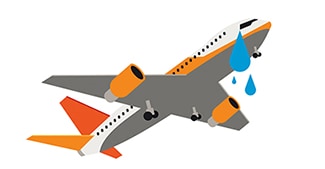The Crying Plane: Why You’re Likely to Tear Up In-Flight
Share

This story was originally published in “The Journey Issue” of APEX Experience magazine.
The 2003 film Love Actually opens with a series of emotional exchanges at the arrivals gate of Heathrow airport: smiling couples beginning their holiday, families reuniting, and travelers returning home to hugs and happy tears. Over this heartwarming montage, Hugh Grant’s voice tells us that, “Love really is all around us.” Love may be grand, but it’s not the only emotion playing into air travel.
Anxiety over a delayed flight, fury at a missed connection, nervousness for a lengthy security check, sadness about leaving a loved one, reservations about an unfamiliar destination, and fear of flying are just a few of the frequent emotions passengers may experience. Crying is a natural response to these situations, and often occurs when we feel overwhelmed or unable to express ourselves through dialogue or action. Once we settle onto the aircraft, our seats become a safe place to let a few tears out, miles above the ground and suspended between time zones.
“Crying can be very therapeutic as it is a natural stress relief, so it’s important not to interrupt that process.” – Rebecca Turnbull, clinical counselor
Surrender Control
Whether for holidays, business trips, relocation or visiting family, travel is often a stressful experience. Getting to the airport on time can be a challenge, and the strain of remembering to pack everything as well as leave instructions for the cat-sitter can result in exhaustion by the time you board the airplane. Many times the full effects of the stress you’ve been under won’t surface until you have some time for yourself. The flight has taken off and there’s finally a minute to relax and reflect, and possibly have a glass of wine. Your phone is switched off, you’re alone with your thoughts and you have nothing to do for the next seven hours but sit and wait. The responsibility of the journey lies in the hands of the pilot and crew and temporarily, at least, control is no longer yours. That moment of calm once the seatbelt sign turns off is very often when suppressed emotions surface.
 Weep Warning
Weep Warning
In 2011, Virgin Atlantic issued Emotional Health Warnings prior to showing films deemed tear-jerkers on board their aircrafts. Over half of travelers surveyed by Virgin Atlantic said they had experienced heightened emotions while flying. This “weep warning” served to normalize the idea of crying on the airplane and assure passengers they weren’t alone in getting a bit teary in their seat.
Everyone has a story about crying on an airplane, especially when traveling alone. There’s a bond between travelers – a shared sense of anonymity combined with an understanding of the vulnerabilities implicit in air travel. But there’s also a feeling of isolation that comes with being in close proximity to hundreds of strangers. Each is in their own bubble, experiencing their own beginning or ending. The isolation that occurs when feeling alone in a highly occupied area can make the urge to cry even more difficult to overcome.
Saltwater Therapy
“When we’re anxious we take short, shallow breaths, which sends a message of fear or panic to our brain. When we are in this state it becomes difficult to access our left brain which is where we store our logic and reasoning,” says clinical counselor Rebecca Turnbull. “Crying can be very therapeutic as it is a natural stress relief, so it’s important not to interrupt that process.”
Caring Crew
Customer service is a crucial part of the in-flight experience and airlines know this. The crew wants passengers to enjoy their flights and seeing tears in the cabin indicates the opposite experience. “When I see a passenger in tears I approach them,” shares one flight attendant. “I try to be authentic and reassure the passenger that they’re in good hands. I’ll offer my assistance and a tissue. It’s not the airline’s responsibility, necessarily, to provide emotional support to passengers, but it’s human instinct that as flight attendants we want to do everything we can to ensure passengers have a good flight.”
“I’ll offer my assistance and a tissue. It’s not the airline’s responsibility, necessarily, to provide emotional support to passengers, but it’s human instinct…” – flight attendant
Xina Feldman, previously with Zoom Airlines, observed, “Air travel is always tiresome and amplifies any stress or emotion a passenger might be feeling. In a pressurized cabin, passengers can be uncomfortable which also makes them sensitive. I’ve often seen grown adults sucking their thumbs, cocooned into a blanket. People want comfort to ease the stress of traveling and often a few tears will be the outlet that provides relief.”
British Airways’ long-haul flights feature a well-being video advising passengers how to enhance their in-flight comfort. Sleep channels offer soothing programs to help customers relax. For those especially anxious, British Airways also offers “Flying With Confidence,” a course available on land pre-flight for those who’d like to combat their fear of flying
Sob Stories
“I’ve flown to weddings, funerals, bridal showers, holidays, visiting family, moving countries, starting school and I’ve never quite felt organized or ready as I board,” says frequent flyer Nicole Lajeunesse. “As the plane takes off I feel a huge sense of relief that I can’t do anything further. Whatever is forgotten is forgotten. It’s usually during takeoff when I get a moment to reflect on where I’m going, who I’m leaving and what adventures await. There are often a few tears as the plane leaves the runway. I rarely begin a journey feeling relaxed and sometimes tears are what calm me down.”
Getting emotional during flight is common and nothing to worry about. As Virgin Atlantic’s “weep warning” advises, keep tissues on hand and press the call button if you need a shoulder to cry on. Otherwise the best advice is to settle in, enjoy the peace and quiet, and let the tears flow.


